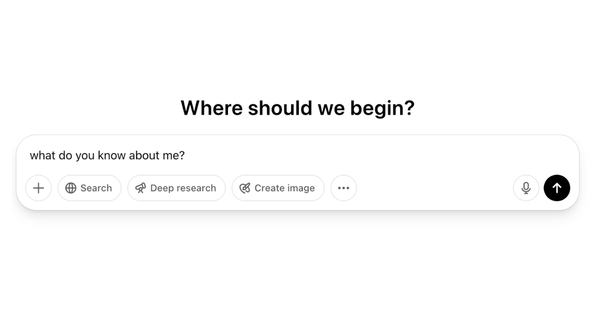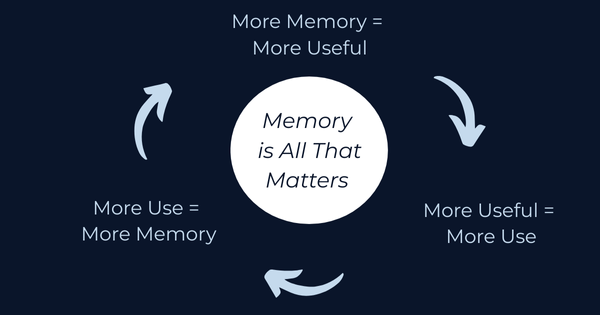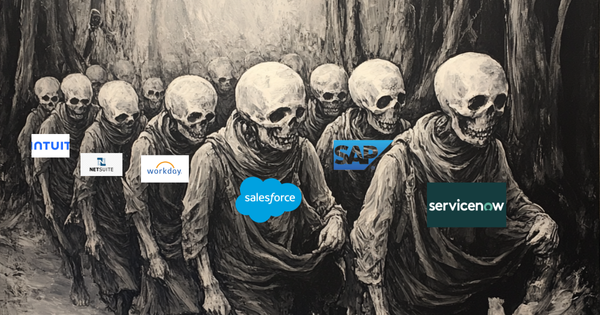Centralizing AI

Warren Buffet’s late business partner Charlie Munger was fond of mental models.
One of my favorite is summed up in the following quote:
“Invert, always invert”
As an air traffic controller in WW2, Charlie’s job was to ensure no planes crashed.
To accomplish this he listed out all the things he would do if he wanted to crash a plane.
Then, all he had to do was make sure he never did any of those things.
I’m working to decentralize AI.
So I'm following Charlie's advice and asking:
What would I do if I wanted to centralize AI?
My strategy would be simple:
- Control the tech – Own the user interface, memory, AI algorithm, and hosting.
- Control the ecosystem – Ensure developers and creators build on my company’s AI system, and not someone else's.
Here’s how I would execute this strategy:
Big Tech rose to dominance by leveraging decentralizing technology (the internet) to build centralized dominance.
So I’d simply steal their playbook:
Step 1: Build a Great Product People Love
Before Big Tech was Big Tech, they built products people loved.
Apple revolutionized phones.
Google mastered search speed and relevance.
Centralizing AI:
For the best AI system, I would focus on:
- Interface: Design a simple, intuitive user interface
- Memory: Improve personalization with usage
- AI: Leverage my own data centers or partner with a Big Tech company to train the most advanced AI model.
- Hosting: Offer as a Software-as-a-Service (SaaS) platform, making it as easy to use as email or any other software.
- Ecosystem: Build developer-friendly API for seamless integration with my AI system. Allow businesses to freely monetize.
And finally, raise venture capital so I could offer users my system for free.
Step 2: Build Network Effects
Big Tech built platforms, not just products.
Platforms leverage network effects: the more users, the more valuable they become.
Like phones: useless alone, vital with millions of users.
Big Tech platforms create self-reinforcing cycles of user and developer growth.
Users' data being tied to these platforms makes switching costs high, strengthening the network effect.
Centralizing AI:
I’d design each component of my AI system to create network effects:
- Interface: Turn the interface into a communication tool not just for AI but for collaboration among users. Allow users to share AI interactions and collaborate on projects when using my interface.
- Memory: Enable users to share data and insights. Example: If I use AI to invest successfully, I can share that memory with others who want to leverage the same investment strategy.
- AI: Train my AI algorithm on user interactions and tailor outputs based on aggregated insights from all users. Implement feedback loops so users can refine outputs, further improving my AI.
- Hosting: Aggregate users to offer hosting at prices competitors can’t match.
- Ecosystem: Empower developers with easy and open API. Foster a community where users share tools, data, and educational resources. Offer free access to my user base for anyone building on my AI system. Take no cut of their revenue.
Step 3: Move from an Open System, to a Closed System
In his book Read, Write, Own, Chris Dixon describes the “attract, extract cycle,” a key strategy Big Tech has used to centralize markets.
Here’s how it works:
Attract Phase:
Platforms start with low-cost or free services, open ecosystems, and user-friendly policies to attract users and developers. APIs are accessible, integration is straightforward, and barriers to entry are minimal.
Extract Phase:
Once the ecosystem is thriving and users are locked in, platforms tighten control.
For example, Facebook restricted API access after developers had built businesses on its platform.
And Apple’s App Store is closed so it can charge high fees and impose strict rules.
Centralized companies don’t play on a level field.
They own the field.
Apple’s App Store policies dictate how apps can operate on iOS.
Google’s search algorithms shape what businesses succeed online.
These companies act as both players and referees in their ecosystems, ensuring they always come out on top.
Centralizing AI
I would steadily close open components of the system through explicit barriers or proprietary formats.
- Interface: Make it difficult or impossible for users to interact with each other outside of my system.
- Memory: Make it difficult or impossible for users to export their memory, and use it on another platform.
- AI: Disable the ability to use my AI algorithm outside my ecosystem.
- Hosting: Make it impossible for users to migrate the AI system to another hosting platform.
- Ecosystem: Close API access to systems that are competitive or potentially competitive. Introduce proprietary standards exclusive to my platform. Mandate that businesses built on my platform sell their products and services exclusively through my marketplace, taking a significant cut of revenue.
Finally, I’d start charging users either explicitly (via increased prices) or implicitly (by selling user data).
Step 4: Leverage Economies of Scale
Big Tech used economies of scale to build unbeatable advantages.
This explains their continued high growth rates even at their massive scale.
At this stage the possibilities are endless, but here are a few examples:
1. Use Scale to Undercut Competitors
Big Tech's massive user base lets them commoditize and crush competitors.
Example: Microsoft included Teams in Office 365 for free to kill Slack. This forced Slack to sell to Salesforce.
Centralizing AI:
I'd bundle all AI services in one monthly subscription.
Anytime a competitor came out with a new service, I’d copy it, and offer it to my existing users for free.
2. Use Scale to Influence Policy & Create Regulatory Capture
Big Tech shapes regulations to benefit themselves.
Centralizing AI:
I'd hire former regulators into lucrative positions.
I'd establish my company as an AI ethics leader.
I'd fund research portraying open source as dangerous while promoting centralization.
I'd advocate for complex regulations only large companies can navigate.
3. Out-Compensate Competitors for Talent
Scale provides means to attract and keep top talent.
Big Tech acquires startups mainly for their teams.
Public status lets them offer stock options competitors can't match.
Centralizing AI:
I would:
Offer unmatched compensation packages.
Buy promising AI startups above market value.
Use long stock vesting periods as golden handcuffs.
The Bottom Line
The path to AI centralization is clear and well-tested:
Build something people love, create powerful network effects, gradually close the system, and leverage scale to maintain dominance.
And these techniques can be even more effective in AI, where data advantages and network effects are potentially stronger.
So now that we understand this, the next question is how do we stop this from happening?
Stay tuned for my next post to find out.
And thanks for reading!
Dave





